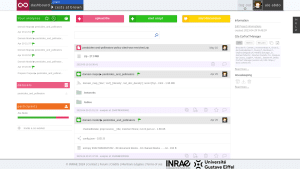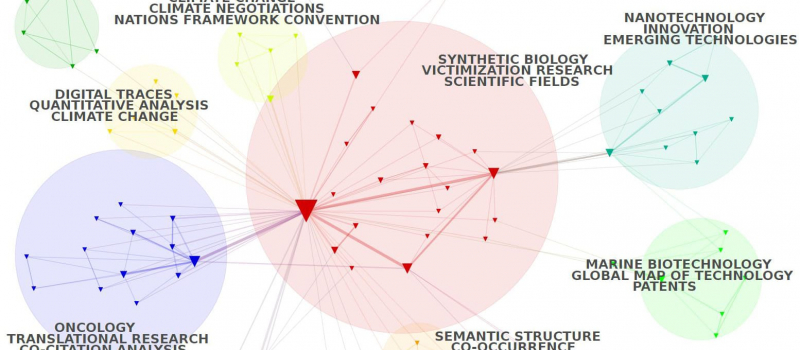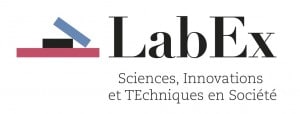Cortext platform
At Cortext, our goal is to empower researchers in the social sciences and humanities by promoting advanced qualitative-quantitative mixed methods. Our primary focus is on studies about the dynamics of science, technology and innovation, and about the roles of knowledge and expertise in societies.
We understand the move towards digital humanities and computational methods not as addressing a technological gap for the social sciences, but rather as entailing entirely new assemblages between its disciplines and those of modern statistics and computer sciences. We work to tackle ever more complex research problems and deal with the profusion of new and diverse sources of information without losing sight of the situatedness and reflexivity required of studies of human societies.
Cortext is hosted by the LISIS research unit at Gustave Eiffel University, and was launched by French institutes IFRIS and INRAE, receiving their continued support.
Cortext Manager

You upload a textual corpus in order to analyse its discourse, names, categories, citations, places, dates etc, with methods for science/controversy/issue mapping, distant reading, document clustering, geo-spatial and network visualizations, and more.
You can jump straight to Cortext Manager and create an account, but we strongly suggest taking a look at the Documentation and Tutorials as you start your journey.
Latest journal articles employing our instruments
Journal Articles
2018
Munk, Anders Kristian
Genanvendt: Et kritisk tilbageblik på digitale metoders konsekvenser for kontroverskortlægningen Journal Article
In: Tema: Digitale metoder, vol. 29, no. 1, 2018.
@article{Munk2018,
title = {Genanvendt: Et kritisk tilbageblik på digitale metoders konsekvenser for kontroverskortlægningen},
author = {Anders Kristian Munk},
url = {https://rauli.cbs.dk/index.php/dansksociologi/article/view/5722/6370},
doi = {https://doi.org/10.22439/dansoc.v29i1.5722},
year = {2018},
date = {2018-04-04},
urldate = {2018-04-04},
journal = {Tema: Digitale metoder},
volume = {29},
number = {1},
abstract = {Digitale metoders centrale postulat er, at vi kan genanvende nettets medier til at sige noget om samfundet i øvrigt. Det gælder ikke mindst indenfor kontroverskortlægningen,hvor digitale medier er blevet væsentlige skuepladser for diskussioner om ny viden og teknologi. Begrebet genanvendelse synes at indebære, at en eksisterende metodisk og analytisk tradition finder nye måder at bruge nogle redskaber på. Vi kan således have en tendens til at spørge, hvordan kontroverskortlægningen har fundet nye anvendelser for værktøjer til eksempelvis mønstergenkendelse eller automatiseret tekstanalyse. I denne artikel argumenterer jeg for, at vi bør stille spørgsmålet om genanvendelse anderledes. Efter 15 år i tæt parløb med nettets indfødte medier og metoder kan vi konstatere, at det også er kontroverskortlægningen selv, der har forandret sig; at det i nogen grad også er den metodiske og analytiske tradition, der er blevet genanvendt til nye formål og i sine nye redskabers billede.},
keywords = {},
pubstate = {published},
tppubtype = {article}
}
Matos, Fábio L; Ross, Steve W; ann ida Huvenne, Veerle; Davies, Jaime; Cunha, Marina R
Canyons pride and prejudice: Exploring the submarine canyon research landscape, a history of geographic and thematic bias Journal Article
In: Progress in Oceanography, 2018.
@article{matos2018canyons,
title = {Canyons pride and prejudice: Exploring the submarine canyon research landscape, a history of geographic and thematic bias},
author = {Fábio L Matos and Steve W Ross and Veerle ann ida Huvenne and Jaime Davies and Marina R Cunha},
url = {https://doi.org/10.1016/j.pocean.2018.04.010},
doi = {10.1016/j.pocean.2018.04.010},
year = {2018},
date = {2018-01-01},
urldate = {2018-01-01},
journal = {Progress in Oceanography},
publisher = {Elsevier},
abstract = {We mapped submarine canyon research using a scientometric approach to define and characterize its scientific landscape based on a comprehensive bibliographic dataset. The abundance of studies covering structural and functional aspects of submarine canyons allowed us to identify the existing knowledge clusters, historical trends, and emergent topics in canyon research. Our analysis documented a network of knowledge clusters of which four were particularly relevant: a strong cluster on “Geology & Geophysics”, well established since the beginnings of canyon research; a cluster on “Biology & Ecology” that gained strength primarily over the past two to three decades; a cluster on “Oceanographic Processes” which occupied a central position in the network and connected strongly to almost all the other clusters and especially to the fourth main cluster on “Modelling”. A smaller, but also well connected, cluster on “Biogeochemistry” related closely to “Biology & Ecology”, and three other small clusters (“Sedimentology”, “Sediments & Tidal Currents”, “Canyon Sampling”) bridged the main clusters. Finally, we identified three small, but specific satellite clusters (“Oil & Gas”, “Chemosynthetic Communities”, “Molecular & Symbionts”). The high-level structure of the knowledge network reflects a latent interdisciplinarity in canyon research. However, the evolution of the research lines over the past nine decades suggests that this pattern arose mostly in the new millennium. Emergent research topics in the last decade also reveal a concern regarding anthropogenic impacts and climate-driven processes. Our results also show a well implemented and international collaboration network, although research efforts have been mainly directed towards only a few canyon systems. A geographical and thematic bias also characterizes canyon research, with specific topics addressed preferentially in particular canyons by different leading research institutions. This spatial and thematic bias, together with the paucity of truly inter-disciplinary studies, may be the most important limitation to integrated knowledge and development in canyon research and hinders a global, more comprehensive understanding of canyon patterns and processes. The scientific landscape mapping and the complementary results are made available as an open and interactive platform that canyon stakeholders can use as a tool to identify knowledge gaps, to find key players in the global collaboration network and to facilitate planning of future research in submarine canyons.},
keywords = {},
pubstate = {published},
tppubtype = {article}
}
Akkari, Monia El; Sandoval, Mélanie; Perchec, Sophie Le; Réchauchère, Olivier
Textual Analysis of Published Research Articles on the Environmental Impacts of Land-Use Change Journal Article
In: Sustainable Agriculture Reviews, vol. 30, pp. 15-38, 2018.
@article{Akkari2018,
title = {Textual Analysis of Published Research Articles on the Environmental Impacts of Land-Use Change},
author = {Monia El Akkari and Mélanie Sandoval and Sophie Le Perchec and Olivier Réchauchère},
url = {https://doi.org/10.1007/978-3-319-96289-4_2},
doi = {10.1007/978-3-319-96289-4_2},
year = {2018},
date = {2018-01-01},
urldate = {2018-01-01},
journal = { Sustainable Agriculture Reviews},
volume = {30},
pages = {15-38},
abstract = {Regardless of the scale considered, land use is determined by a variety of factors relating to both local soil and climatic conditions and socioeconomic considerations (population growth, food and energy requirements, public policies, etc.). Changes in land use resulting from shifts in these factors over time will have environmental consequences. We conducted a review of the scientific literature to identify the degree to which environmental assessments take direct and indirect land-use change into account. A textual analysis was completed on a collection of 5730 scientific articles, published between 1975 and 2015 and listed in the WoS™ database, addressing the relationship between reorganizations of agricultural and forestry systems, or spatial planning, direct and indirect land-use change resulting from these reorganizations; and environmental impacts. By identifying the most frequently used words or groups of words within this corpus (focusing on the title, abstract, and keywords fields), the textual analysis platform CorTexT Manager (Platform developed by IFRIS (the Institute for Research and Innovation in Society, based in the Paris region) assembles diagrams, or “maps,” of occurrence and co-occurrence for these terms, which can then be used to identify the principal themes addressed in the corpus based on clusters of proximate keywords. Eight clusters were so identified: two focused on climate change and greenhouse gas fluxes in terrestrial ecosystems (thus corresponding both to an aspect of the biophysical context and an environmental impact linked to a reorganization); one associated a reorganization (biofuel production) with a dominant environmental impact (the effects of greenhouse gas emissions); three were centered on keywords related to other types of reorganizations (urbanization, grassland management, forestry management); and two focused on environmental impacts on biodiversity and water resources. The five “thematic identifiers” showing the highest number of occurrences were greenhouse gas emission, land-use policy, biofuel, farm system, and pasture land, suggesting that the theme “GHG impacts of biofuel production” is the most prevalent. A more detailed textual analysis of articles in the cluster relating to non-food biomass production (1785 articles) was also conducted, and confirmed the growing importance, notably since 2005–2006, of research linking the bioenergy production, land-use change, and climate impacts from greenhouse gas emissions. Reorganizations toward non-food biomass production also help explain the presence of degraded lands among the most frequently occurring terms in the corpus. Life-cycle analysis is the most important assessment methodology used to evaluate the environmental impacts of bioenergy production.},
keywords = {},
pubstate = {published},
tppubtype = {article}
}
Makowski, David
Mapping the Evidence on the Environmental Impacts of Land-Use Change for Non-food Biomass Production Journal Article
In: Sustainable Agriculture Reviews, vol. 30, pp. 227-236, 2018.
@article{Makowski2018,
title = {Mapping the Evidence on the Environmental Impacts of Land-Use Change for Non-food Biomass Production},
author = {David Makowski},
url = {https://hal.inrae.fr/hal-02904528
https://link.springer.com/content/pdf/10.1007/978-3-319-96289-4.pdf#page=237},
doi = {10.1007/978-3-319-96289-4_10},
year = {2018},
date = {2018-01-01},
urldate = {2018-01-01},
journal = {Sustainable Agriculture Reviews},
volume = {30},
pages = {227-236},
abstract = {The environmental impact of land-use change for biomass production is controversial, and it is crucial to provide stakeholders with a reliable description of the existing evidence on this topic. In this paper, we use an emerging research synthesis method called “evidence mapping” to summarize the main characteristics of 241 studies in a graphical user-friendly format. Results showed that most of the reviewed studies were located in Northern and Southern Americas, especially in USA and Brazil. A majority of studies focused on 1G and 2G biofuel, and on electricity production. The impacts on greenhouse gas emission, soil carbon content, soil erosion, water consumption, and water eutrophication were frequently assessed in the selected group of studies. The evidence maps produced in this paper revealed that only few studies were conducted to analyse the environmental impact of Land use change for methane production, for wood production, and for the chemical industry. Only few studies assessed the impact on biodiversity, on air quality, on human health, and on waste induced by land-use changes for biomass production. Our results thus highlight major gaps of knowledge and future research needs on the land-use-mediated implications of the bioeconomy.},
keywords = {},
pubstate = {published},
tppubtype = {article}
}
NotesVIEW ALL
-
Long trends on twitter: intertemporal clusters combining hashtags and terms on Scientometrics, Altmetrics, Bibliometrics and Science Of Science
Long trends on twitter: inter-temporal clusters combining hashtags and terms, for all tweets on Scientometrics, Altmetrics, Bibliometrics and Science Of Science from Jan. 2017 to dec. 2021, on a semester base. Query used to extract tweets: lang:en (Scientometrics OR “ScienceOfScience” OR “Science Of Science” OR “Altmetrics” OR “altmetric” OR “bibliometrics” OR “bibliometric” OR “citation metrics” […]
-
Présenter CorTexT Manager en 2 minutes
Cortext Manager est une application web construite par des chercheurs et par des ingénieurs à destination de chercheurs en sciences humaines et sociales, au plus près des questions portées par les chercheurs qui nous entourent et par notre communauté d’utilisateurs. Cette application web peut produire un grand nombre d’analyses différentes qui ont trait aux champs […]
-
Analysis of the scientific production that mentioned the use of CorText Manager
There are two ways to understand what CorTexT Manager is. The first one is to look at what has been achieved in terms of methods, tools and therefore lines of code. The second one is studied below, by analyzing (here with CorTexT Manager) what academic users have published using… CorTexT Manager. Our study of the […]
-
10 years of CorText Manager v2
It took us more than 10 years to come with CorText Manager version 2 as it is now! Behind the scenes CorText Manager begun with a first version in 2009. More than thirty contributors has worked directly or indirectly on the two versions, year after year. All the ideas, inspirations, all this accumulation of pieces […]
-
RISIS Training: Thematic and spatial analysis of technologies using CorText Manager and RISIS patent database
One of the best CorText Manager training courses was organized and offered by the RISIS project. Here is the program of this training which lasted 3 days: Monday 08/11/21 14h-16h30: Session 1 Session 1a: Introduction on patent analysis (60’) Introductory lecture session • Welcoming introduction (Philippe Larédo) 5’ • Type of patents documents (Antoine Schoen) […]
-
Early 2021 CorText Manager training sessions
CorText organized a series of training workshops on CorText Manager and its methods in January 2021! These workshops were imagined as a staircase with three successive steps : Session 1: Introduction Session 2: Method comparisons Session 3: Research questions and work on user’s corpus For these sessions, the subject chosen for the demonstrations and exercises […]
-
Seminar and workshop during the Summer School of PPGCI IBICT UFRJ, Rio de Janeiro – 03/2020
In March 2020, the LabEx SITES post-doctoral researcher, Ale Abdo, traveled to Rio de Janeiro and São Paulo to organize two trainings on textual analysis and on a new method he developed and integrated at the CorText Infrastructure, as well as to participate in discussions on open and citizen science in Brazil, including the discussion […]
-
A CorText Manager distance training session in the framework of the nanocellulose project – Grenoble, June 2020
For complementing the RISIS access requested (to Leiden publications DB and RISIS patent DB) by the GAEL laboratory (UMR INRAE, CNRS, UGA, INPG), in the framework of a research project on nanocellulose, the CorText team has provided , in June and July 2020, an advanced training on the use of CorText. After setting up of […]
CorText Newsfeed
Want to stay up-to-date with the latest training sessions and developments in our methods and data? We invite you to subscribe to Cortext Newsfeed, our succint and researcher oriented quarterly newsletter.
Read the previous editions of our newsletter








